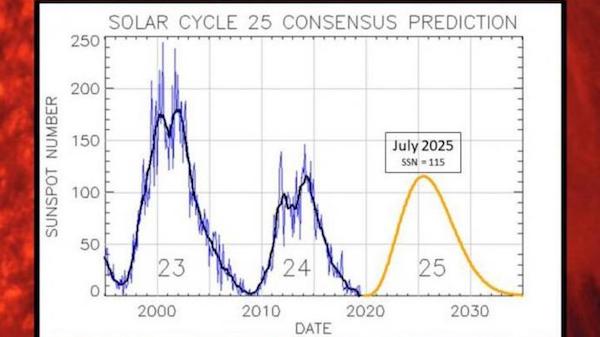Our planet’s star is on its way to what’s known as “solar maximum” and scientists think it now could peak by the end of 2023, about a year and a half earlier than previously predicted. Unfortunately, according to experts, our planet may be dangerously underprepared.
The Sun’s solar cycle typically lasts anywhere from 9 to 12 years, though it can be up to 15 years. “Solar Cycle 1” was documented between 1755 and 1766. We are now in Solar Cycle 25. Over the course of a cycle, the Sun’s activity gradually increases from a low point, known as solar minimum, to its peak, aka solar maximum. Once reaching solar maximum, the Sun’s magnetic fields completely flip, meaning the north pole becomes the south pole, and vice versa. It’s the period of activity before the flip happens that is the real concern, though.
As the Sun approaches solar maximum, there is a dramatic increase in things like solar storms and coronal mass ejections (CMEs) that shoot out high-energy particles. According to Alex James, a solar physicist at University College London, earlier in the solar cycle, the Sun’s magnetic field acts like a “giant forcefield” that essentially contains superheated plasma, or ionized gas, close to the surface, suppressing solar activity. But the field gradually becomes tangled, with some regions becoming more magnetized than others. As a result, the sun’s magnetic field gradually weakens, and solar storms begin to ramp up.
Solar storms include solar flares and coronal mass ejections (CMEs). Solar flares are eruptions of electromagnetic radiation launched from sunspots into the sun’s atmosphere. The most powerful solar flares are “X-class” flares, which are the least common type. The smallest ones are A-class, followed by B, C, and M. Within each letter class there is a finer scale from 1 to 9 (M-1 to M-9, for example), although X-class flares have no scale limit. The most powerful flare measured with modern methods was in 2003, during the last solar maximum, and it was so powerful that it overloaded the sensors measuring it. The sensors cut out at X-28.
Sometimes solar flares are accompanied by enormous blasts of electromagnetic plasma, known as coronal mass ejections (CMEs). CMEs travel outward from the Sun at speeds ranging from slower than 155 miles per second (mps) to as fast as 1,865 mps. The fastest Earth-directed CMEs can reach our planet in as little as 15-18 hours. Slower CMEs can take several days to arrive. They expand in size as they propagate away from the Sun and larger CMEs can reach a size comprising nearly a quarter of the space between Earth and the Sun by the time it reaches our planet.
The primary way scientists track solar cycle progression is by counting the number of sunspots on our home star’s surface. These dark patches generally accompany solar activity. In May of this year, nearly 140 sunspots were documented. And solar activity has definitely ramped up. There have already been eight X-class flares this year, including one in May that knocked out radio communications across southeast Asia, Australia, and New Zealand. A CME erupted from the Sun on April 21. These and other unusual solar phenomena indicate that the solar maximum is going to peak sooner and stronger than predicted.
Past cycles suggest the solar maximum may last for somewhere between one and two years, though scientists don’t know for sure. The potential damage that might be experienced on Earth primarily depends on whether solar storms barrel into Earth, according to Tzu-Wei Fang, a researcher at NOAA’s Space Weather Prediction Center. To hit Earth, solar storms must be pointing in the right direction at the right time. Increases in solar activity make this more likely but don’t guarantee the planet will be slammed with more storms, says Fang.
Strong storms can ionize Earth’s upper atmosphere and fuel radio and satellite blackouts. Big storms that block the planet’s connections to satellites can temporarily wipe out long-range radio and GPS systems for up to half the planet, according to Fang. Strong solar storms can also generate ground-based electrical currents that can damage metallic infrastructure, including older power grids and rail lines. Such outages could last for months. The northern latitudes are especially vulnerable to solar storms, where a lot of internet infrastructure is concentrated.
An ionized upper atmosphere also becomes denser, which can create additional drag for Earth-orbiting satellites. This extra drag can push satellites into each other or force them out of orbit. In 2022, 20 Starlink satellites plummeted back toward Earth and burned up in the atmosphere after being hit by a geomagnetic storm. Feng notes that the number of satellites orbiting Earth has exponentially increased since the last solar maximum. Most are operated by commercial companies that rarely factor space weather into satellite design or launch schedules, according to Feng.
While the Earth has withstood plenty of bombardments from the Sun, our modern-day infrastructure has never been tested by the most extreme events. The economic losses could reach into the trillions and the impact to everyday life would no doubt be enormous. Unfortunately, there is little that everyday people can do to protect themselves, as most of what can be done falls under the purview of government and private industry. Let’s hope they are paying attention! (Sources: Live Science, NOAA, SpaceWeather)









